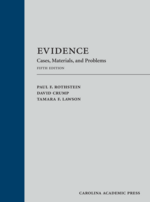This title has been replaced by a newer edition:
Evidence: Cases, Materials, and Problems, Fifth Edition
2019, 858 pp, casebound, ISBN 978-1-5310-1232-8
$220.00
Teacher's Manual available
Evidence
Cases, Materials, and Problems
Fourth Edition
by Paul F. Rothstein, Myrna S. Raeder, David Crump
2013
Tags: Evidence
970 pp $202.00
ISBN 978-0-76984-889-1
eISBN 978-0-76988-881-1
View or download the free 2015 Online Supplement for this product.
Evidence: Cases, Materials, and Problems is predicated more than ever on the notion that the Federal Rules of Evidence, their state progeny, and cases arising under them, are the major factors in the teaching of Evidence today. The authors have made some changes to build the book more explicitly around the Rules. Interesting or informative cases or materials from other jurisdictions or the common law are still included where those materials shed light on an issue or impart perspective by showing other ways of doing things. For instance, the significant differences such as those in California are highlighted while the authors still use the Federal Rules as the basic organizing principle for this edition. The general plan of the book is this. Each section starts out with a directive to read a particular rule or portion thereof. This may be followed by a brief background explanation of the area, if needed. Then come some essential and teachable cases and other primary materials, each usually followed by a set of expository notes (including some questions) exploring permutations and implications, and finally, some problems testing whether students can apply or critique what they have learned and integrate it with other topics and rules where necessary. Each note, question, or problem has a heading indicating what it treats, so that professors are able to identify the subjects they wish to cover, while students receive direction about the intended focus of each inquiry. The materials in this book cover a wide range of perspectives from intensely pragmatic concerns, through deeply philosophical policy issues, to new approaches to evidentiary analysis. Included are textual explanations, rules, cases, notes, questions, problems, jury instructions, articles, proposals, legislation, and excerpted testimony. Assignments may be tailored to suit the teacher's own preferences on how to best approach Evidence in an introductory course.
From both Professor Rothstein and Professor Crump: To our beloved co-author Myrna Raeder, who did not see the publication of this volume, but whose work runs through all of it, and whose insight, wisdom and good humor stay with us after all these years.
This book also is available in a three-hole punched, alternative loose-leaf version printed on 8.5 x 11 inch paper with wider margins and with the same pagination as the hardbound book.



